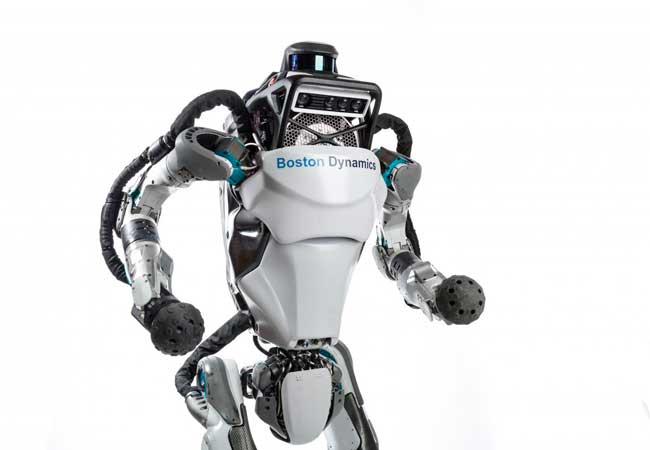BOSTON DYNAMICS WILDCAT. The WildCat robot is the world's fastest free-walking four-legged robot, with a speed of 32 km/h. The preceding speed record was 21 kilometers per hour and was set at the Massachusetts Institute of Technology in 1989. The WildCat is powered by an internal combustion methanol engine that drives a hydraulic drive system (and makes a sound). The robot employs a range of gaits, including bobcat, canter, and gallop, to maintain its balance while moving over reasonably flat ground.
The onboard computer uses dynamically controlled algorithms and various sensors to monitor and steady the motion as it walks. It uses a series of laser rangefinders to accurately measure the height and position of the robot above the terrain. The WildCat stabilizing steering system was pioneered on Cheetah, a test prototype that ran 48 km/h quicker than Usain Bolt. The Cheetah ran windless on a treadmill, was forced to move in an airplane, and was powered by a huge remote power source.
BOSTON DYNAMICS BIGDOG.
The first advanced all-terrain vehicle. The first robot to leave the lab and face the actual life world. BigDog features four legs, hinged just like an animal's, with malleable elements that absorb shock and return power from one stride to another. The BigDog is about the size of a larger dog or a more miniature mule. The BigDog's onboard PC controls the movement, processes sensor readings, and provides user communication. The BigDog guidance system maintains equilibrium, controls movement over varying ground conditions, and guides guidance. Locomotion sensors consist of joint positions, joint forces, contact with the ground, earth load, a gyroscope, LIDAR, and a system for stereovision.
Further sensors focus on the interior of the BigDog and control pressure in the hydraulic system, the temperature of the oil, motor function, low battery, and more.
DARPA has funded the development of the original BigDog robot. The work to add a manipulator and perform dynamically controlled manipulations was funded by the Army Research Laboratory's RCTA program.
BOSTON DYNAMICS SANDFLEA.
Sand Flea is a small robot with 4 steering wheels and a solid jumping leg. It rides like an RC car on the level ground yet can leap 10m in the air to jump over hurdles. This is high enough to leap over a complex wall, across the top of a building, up a flight of stairs, or through a 2nd-floor window. The robot utilizes its wheels as gyroscopes to stay level during flight, giving the operator a crisp look out of the onboard camera and providing fluid landings thanks to the four-wheel steering. The Sand Flea can bounce about 25 times on a single load. Boston Dynamics designed the Sand Flea with financial support from the U.S. Army Rapid Equipping Force (REF), DARPA, and Sandia National Laboratory. The SandFlea is presently under production.
BOSTON DYNAMICS RHEX.
Absorbs uneven topography. RHex is a highly mobile, passively stable, six-legged robot. RHex is a six-legged bot with excellent cross-country mobility. Autonomously steered legs produce a specialized walking gait that propels it over rough ground with minimum effort from the human operator. The RHex traverses rocky fields, mud, sand, vegetation, railroad tracks, telephone poles, and stairs.
Front and rear cameras give the operator a long-range view of the RHex surroundings. The sealed housing makes the RHex fully operational in wet weather, muddy and swampy conditions, and flowing culverts. The RHex's remarkable off-road capabilities have been confirmed in independent government testing. RHex was developed with the financial support of DARPA and the US Army Rapid Deployment Force.




